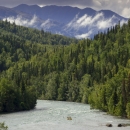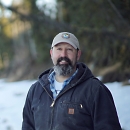This project is designed to continue to support and sustain salmon recovery, improve fishery resources, prioritize fish passage fish passage
Fish passage is the ability of fish or other aquatic species to move freely throughout their life to find food, reproduce, and complete their natural migration cycles. Millions of barriers to fish passage across the country are fragmenting habitat and leading to species declines. The U.S. Fish and Wildlife Service's National Fish Passage Program is working to reconnect watersheds to benefit both wildlife and people.
Learn more about fish passage enhancement projects, manage human uses, prioritize strategic habitat protections, and prevent habitat fragmentation. The information garnered from this project will provide science-based decision support information to help inform future habitat conservation work in a more strategic science-based manner focusing on specific needs of the resources (e.g., key tributaries, spawning and rearing areas, etc.).
The long-term sustainability of Coho Salmon in the Kenai River is at risk and preventing further degradation of habitat is critical and has been identified a priority of the U.S. Fish and Wildlife Service and the Alaska Department of Fish and Game. Coho Salmon have been selected due to the paucity of information and the expansive spatial utilization of the landscape often associated with this species. Changing flows, water temperatures, continued development, and the continuous desire to exploit salmon for subsistence, consumptive, commercial, cultural, traditional, and educational purposes are all common threats to the sustainability of salmon. Preferred lands along the mainstem Kenai River are also becoming increasingly unavailable as development continues which is pushing urban sprawl to peripheral areas within the watershed where salmon spawning and rearing is most prevalent and most susceptible to fragmentation.
Radio telemetry, water quality monitoring, genetics, and modeling will be used to identify and describe habitats critical for salmon migration, spawning, staging, and determining specific run timing and abundance for discrete spawning aggregates. This information will provide fishery managers and permitting agencies with the necessary information to maintain the sustainability of a keystone species critical to the local economy and ecosystem.
Fisheries management, Monitoring, Research





